by Winding Pathways | Sep 24, 2020 | (Sub)Urban Homesteading, Garden/Yard, Mammals, Nature
People in Eastern Iowa planting young trees to replace those shattered by the August 10 Derecho need to remember an important step. Protect those vulnerable and valuable young trees.
Here is our story. A distressing sight greeted us one September morning a few years ago as we walked to the mailbox to get the newspaper. Overnight a deer had chosen our favorite young maple tree to polish his antlers. He was thorough and had rubbed the bark off all around the two-inch diameter trunk. It was girdled and doomed.
We should have known better. Buck deer start growing their antlers in April and by about Labor Day, they are full size. Antlers are formed by a blood-rich skin called velvet. By late summer it has dried and bucks rub it off polishing up their antlers for dominance battles with rivals. By neglecting to protect our tree we gave a buck a great rubbing place. And doomed our tree to an early death.
Deer begin rubbing in early fall and sometimes continue until the deer mating season approaches in early November. Deer live in most American cities and regularly roam through suburbs. They are as happy to rub their antlers on an ornamental tree in the front yard as on one back in the woods. It’s never good for the tree.
Deer seem to prefer to rub on saplings with trunks a few inches in diameter. They especially seem to prefer pine and black cherry trees but we have even lost young spruces to their rubs. One thing is predictable. The tree that a family most treasures is the one a buck is likely to destroy.
Damage is preventable. We now run a four-foot-high circle of wire mesh around the tree and wire it to a fence post hammered securely into the ground. Once a tree reaches five or six inches in diameter deer rarely bother them, so the wire is only needed for a few years.
Be sure to water your new, young fall-planted tree. And, protect it with wire mesh.
-
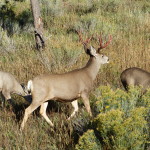
-
With polished antlers, this muledeer buck proudly strode across the meadow. Whitetails are more common in the East and Midwest. “Mulies” are common in the High Plains and west.
-
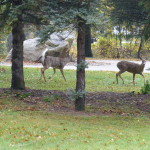
-
On Halloween day a buck was hot on the “tail” of this doe and yearling.
-
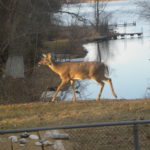
-
Deer in yard.
by Winding Pathways | Sep 10, 2020 | (Sub)Urban Homesteading, Chickens, Garden/Yard
Clouds darkened in the late morning of August 10, 2020, as a thunderstorm warning was broadcast by radio stations. That’s common during Iowa summers, so we weren’t overly concerned. A half-hour later, a roaring wind engulfed Cedar Rapids. It was a derecho bearing winds up to 140 miles an hour.
We watched our young trees bend before the tempest. Then came the terrible part.
First, our black oaks tumbled down. Then, the black cherries and hackberries tumbled down before the wind. Our massive black walnut stood until a ferocious blast tore its branches and leaves off.
The derecho lasted longer than most – over 40 minutes – and left as quickly as it had arrived. The damage was mindboggling. We soon learned that Cedar Rapids lost 65% of its trees. A quick count showed that 47 of our 53 mature trees were either on the ground or stripped of leaves and branches. We lost privacy and shade and gained a view.
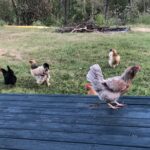
For several days the chickens were truly “free-ranging.”
We worried about our 20 chickens. The storm came so quickly that we couldn’t lure them into the coop. The wind destroyed the chicken run’s fence. The birds were fine and, with the fence down, began their first neighborhood tour. Even before the rain stopped!
We couldn’t erect a temporary fence for several days, so the chickens were truly free-ranging. They roamed around, and we often didn’t even know where they were.
But, every once in a while, a hen returned to the coop to lay her egg in the nest.
Each sundown all the chicks came home for the night. All 20!
With power off and vast damage over a large area, we were fearful about food. Our freezer warmed and the wind damaged many of our garden crops. Would grocery stores reopen????. Could we even get through on the tree chocked roads??? We didn’t know. But it was soon obvious that our hens were nonplussed by the storm and kept giving us fresh eggs.

The chickens kept on laying eggs.
Assuming a chicken flock survives an immediate disaster – flood, fire, or storm – they’ll continue laying nutritious eggs when other food may not be available. They are valuable disaster companions.
by Winding Pathways | Aug 20, 2020 | (Sub)Urban Homesteading, Garden/Yard, Garden/Yard, Weeds
Iowa normally enjoys about an inch of rain a week during the growing season. Not this year. We haven’t had rain for a month and none is in sight. Droughts have their benefits. Most obvious is the dearth of mosquitoes and gnats that thrive during wet years. Less known is what dry spells teach us about plants.

Native plants tend to resist drought better.
As we walked across a large brown lawn in a cemetery, we noticed green healthy plants poking through dead looking Kentucky bluegrass. They were mostly native species well adapted to a month of heat and dryness.
Here’s what the brown lawn taught us:
- Many people spend money and countless hours attempting to create a perfect weed-free green lawn composed of bluegrass and fescue. These shallow-rooted European species are poorly adapted to American dry spells.
- Prairie and other native plants send roots down as far as 15 feet to tap deep moisture that lets them stay green and healthy through droughts.
- Lawns established on rich soil with spongy organic matter stay green much longer than those planted in the poor, compacted soil of housing developments.
- Areas fortunate enough to enjoy some shade stay green longer than counterparts in the sun all day.
Here are tips for anyone wanting a green
yard during late summer’s dryness:
- Replace the lawn with deep-rooted native species.
- If a cropped lawn is important don’t water but:
Build Topsoil: Gradually add compost over the grass. Maybe an inch a year.
Compost fertilizes plants and absorbs and stores rain.
Mow high and infrequently: Forget the “once-a-week” contract. Buzzing off the grass stresses it
and doesn’t allow roots to penetrate deeply.
Promote diversity: A bluegrass monoculture invites problems. Diversity of plant species ensures
that some will thrive no matter what the weather If it’s green when nearby grass is brown,
enjoy its health.
Avoid herbicides: Chemicals tend to kill drought-resistant native plants.
Fortunately, even exotic lawn grasses green up as soon as cooler damp fall weather arrives, but at Winding Pathways we simply allow the brown grass to rest and enjoy our green native plants that have evolved to thrive during dry spells.
by Winding Pathways | Aug 20, 2020 | (Sub)Urban Homesteading, Amphibians/Reptiles, Garden/Yard, Nature
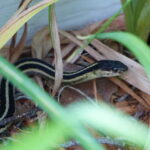
The garter snake lounges in the shade of the cool garden eating insects and worms.
On a July evening, Rich reached down to pick string beans and was startled to spot a garter snake peering up at him from beneath a plant. We’ve seen the three-foot-long snake many times this year around the yard but it seems to particularly like lounging in shade cast by bean plants.
We’re used to snakes, have no particular fear of them, and appreciate their benefits. It’s helpful that no poisonous snakes live in our area. Yet, it’s startling to see one inches from our fingers. “Our” garter snake practices social distancing and is probably more alarmed than we are with an encounter. He or she quickly vacates, letting us pick beans and tomatoes without its company.
What Do Garter Snakes Eat?
Garter snakes are common across the United States and range north into Canada. Constrictors wrap their bodies around a hapless mouse or chipmunk to eventually dispatch it. Garter snakes use a different strategy. They’re versatile carnivores and enjoy dining on insects, worms, slugs, and just about any other small enough animal to fit in their petite mouths. They quickly grab small prey and swallow whole and alive.
How Do Garter Snakes Help in the Yard?
We like our garter snake because of what it represents. If we’d doused the garden with toxic spray to kill insects, we would have no snake. Its presence signifies a healthy yard. Although garter snakes eat both beneficial and harmful insects, they probably devour many more of the latter. And, our compost-rich soil produces an abundance of worms, so the snakes can have all they want. Plenty will survive to aerate the soil.
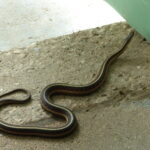
This garter snake was seeking cool shade on a hot summer day.
Startling as our snake may be, it’s as beautiful as a goldfinch or bluebird. Spotting it gives us a moment of joy. After we are done being startled.
- If having a garter snake around really troubles you, Iowa State University Extention has non-lethal ways to reduce the appeal of your yard.
by Winding Pathways | Aug 13, 2020 | (Sub)Urban Homesteading, Birds, Garden/Yard, Nature
This summer we enjoyed watching wren couples set up housekeeping at Winding Pathways. One pair nested in a small box under our porch ceiling, while another chose a box a few feet outside the dining room window.
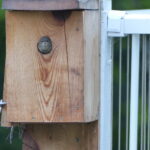
The world is big, bright and intriguing.
We watched these tiny, industrious birds make dozens of trips bringing sticks to make nests. Then, for a few weeks, we saw them infrequently. Only the female visited to lay eggs. Once her clutch was complete, she incubated them for a couple of weeks until they hatched. Then our fun began.
Wren parenting is hard work. Every two or three minutes one parent or the other brought juicy caterpillars and leggy bugs to feed the rapidly growing brood. Baby wrens hatch helpless and blind, but in just a couple of weeks, they grow almost as big as mom and dad. Finally, it’s time to fledge.
On the morning of August 9, we sat on the deck watching a young wren peer out the entrance hole, begging for breakfast. Mom or dad brought bugs, but mostly they urged the youngster, and its siblings, to take the plunge and abandon the only home they knew.
It’s scary. The nest is secure and safe. Mom and dad bring food and keep it clean. Then they expect their kids to leave and earn their own living in a world fraught with danger.
Our young wrens peered outside for a day or two before fluttering into the world. Huddling in low lying vegetation they called hungrily. Fortunately for wrens and many other birds, the adults help them out. We continued to hear these “branchers” calling in the nearby woods and caught glimpses of the parents bringing bugs to them. Slowly the babies figured it out.
After a few days, the young re-appeared around the yard, flying awkwardly. They have much to learn, and all sorts of perils to avoid. The parents continue to support them and many will wing south as the weather cools. We’ll watch for their return next April.
This year millions of American teenagers and new college grads are in the same fix as young wrens. Childhood and Youth are over. Peering out the door and knowing they must leave is scary. It’s tough enough to leave home during normal times, but this year coronavirus is making the transition extra challenging.
Young people heading for college don’t know whether classes will even be held. If so, will they be online or in-person? Will college include exposure to a virus that could sicken or kill? Recent high school and college grads seeking a job face different challenges. High unemployment and lurking viruses can make finding work difficult and, perhaps, dangerous. Join the military? Move across the country for a job? That’s perilous, also. Nothing seems safe. Everything’s confusing.
Like the young wrens, parents still help guide their offspring, providing support, advice, and encouragement as the “young” leave the nest. We send good wishes to the youthful wrens that started life at Winding Pathways and to young people about to launch into a confusing and challenging world. May they all thrive.
-
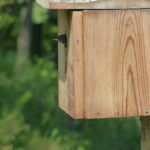
-
This baby is checking out the scenery.
-
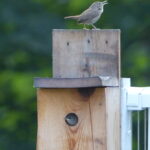
-
Parent encourages the baby.
-
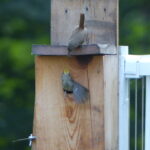
-
The parent dangles tasty morsels, forcing the baby to come outside the nest box.
-
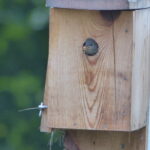
-
This huge bug is a mouthful!
-
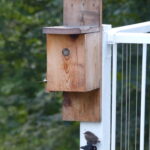
-
A short first flight.
-
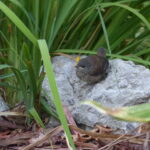
-
This wren fluttered to the ground below the next box.
by Winding Pathways | Aug 6, 2020 | (Sub)Urban Homesteading, Flowers/Grasses, Garden/Yard, Garden/Yard
Learning from the Prairie
Wow. It’s August! We recently completed a management step on the prairie planted in early June. Weeds were outgrowing infant prairie plants that need sunshine. We buzzed off the weeds at the highest setting possible on our battery-powered cordless EGO mower.
We bought this mower because its battery powers a powerful electric mower that easily cuts tough grass while producing less emissions than a gas mower. And, it’s easy to use. No cord pulling to start it. Also, the mow height is simple to set and allows us a high setting that helps with prairie management.
-
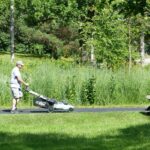
-
The mower and wheelbarrow.
-
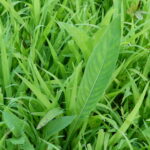
-
Prairie plants among grass.
-
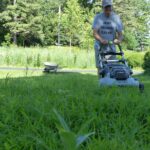
-
Emerging prairie plants will get more sunlight when the competing grasses are mowed off
Afternoon Delight
We planted a prairie in front of the house nine years ago and now spend hours sitting on the front porch reading and talking but always watching the prairie. Here are observations that make us delighted we converted a lawn to the prairie:
- Stunning beauty. We enjoy a changing array of colorful flowers and grasses that dance in the breeze. Coneflowers have been in bloom for a while. Milkweed blooms have faded. And, cupplants are just now coming into their midsummer glory.
- Insects. Monarchs and swallowtails cavort over the prairie on sunny days while stopping to sip nectar. Each evening the air over our prairie swarms with delightful lightning bugs. They are absent over the nearby lawn.
- Wrens, bluebirds, and goldfinches. A pair of wrens nested in a box just above our porch chairs. We love watching these industrious parents make trip after trip foraging for insects to feed the youngsters. They hunt in the prairie and nearby woods edge but not in the lawn. Our prairie enables our yard to support at least four pairs of nesting wrens and one pair of bluebirds. If the entire yard were mowed, we’d be lucky to have one wren couple to enjoy. In mid-summer goldfinches work the prairie.
- Garter and brown snakes. We’ve noticed an increase in garter and brown snakes, both harmless species as beautiful and interesting as goldfinches or cardinals.
-
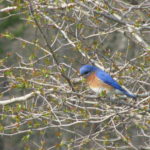
-
Bluebirds hang out on branches.
-
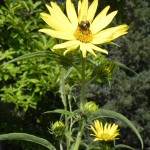
-
This hardy late season bloomer is vital for pollinators and migratory birds.
-
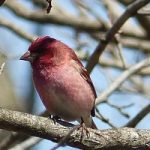
-
Some birds homestead at Winding Pathways.
Phoenix Harmony Labyrinth Prairie
Marion crafted a labyrinth through our oldest prairie on the front yard. She welcomes anyone to walk its circular path. Contact us before you come. The labyrinth is a peaceful way to access the prairie and contemplate the beauty of our earth while walking along its path.
-

-
People call and stop by to walk.
-

-
Visitors can rest and watch the prairie labyrinth.
-
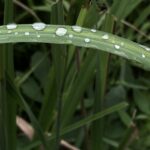
-
Prairie plants capture dew.
-
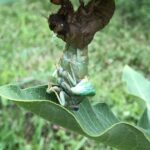
-
A rare treat is watching insect life emerge from one stage to another.
-
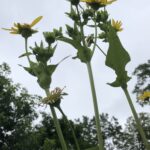
-
Cupplants hold water near their stem. Birds and insects sip
-
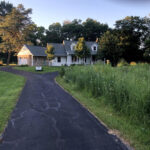
Make Like a Buffalo
When Sustainable Landscape Solutions did ground preparation for our new prairie, I asked Sean Pearl if he’d create two “artificial gopher mounds” in an older prairie in our backyard. He said “Sure.” A while back, we had planted this prairie with just grass seed. It has few flowers, and the roots of the big bluestem, Indiangrass, and switchgrass are tough and dense. Prairie needs disturbance. Once bison wallowed and gophers dug to create bare earth. Many prairie grasses need this bare earth to reseed. We had neither bison nor gophers so used a machine to create bare soil.
Sean’s machine chopped through the grasses. We followed up by planting 82 flower species seeds. Flowers add diversity, color, and attract pollinating insects. Looks like it’s working. Lots of new prairie wildflowers are growing in these two places in the midst of towering grasses.
Our next Prairie Renaissance blog will come in early fall.



























